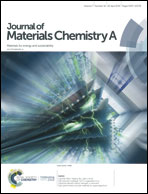Identifying high-efficiency oxygen evolution electrocatalysts from Co–Ni–Cu based selenides through combinatorial electrodeposition†
Abstract
Water splitting has been widely considered to be an efficient way to generate sustainable and renewable energy resources in fuel cells, metal–air batteries and other energy conversion devices. Exploring efficient electrocatalysts to expedite the anodic oxygen evolution reaction (OER) is a crucial task that needs to be addressed in order to boost the practical application of water splitting. Intensive efforts have been devoted to develop mixed transition metal based chalcogenides as effective OER electrocatalysts. Herein, we have reported synthesis of a series of mixed metal selenides containing Co, Ni and Cu employing combinatorial electrodeposition, and systematically investigated how the transition metal doping affects the OER catalytic activity in alkaline medium. Energy dispersive spectroscopy (EDS) was performed to detect the elemental compositions and confirm the feasibility of compositional control of 66 metal selenide thin films. It was observed that the OER catalytic activity is sensitive to the concentration of Cu in the catalysts, and the catalyst activity tended to increase with increasing Cu concentration. However, increasing the Cu concentration beyond a certain limit led to decrease in catalytic efficiency, and copper selenide by itself, although catalytically active, showed higher onset potential and overpotential for OER compared to the ternary and quaternary mixed metal selenides. Interestingly, the best quaternary composition (Co0.21Ni0.25Cu0.54)3Se2 showed similar crystal structure as its parent compound of Cu3Se2 with slight decrease in lattice spacings of (101) and (210) lattice planes (0.0222 Å and 0.0148 Å, respectively) evident from the powder X-ray diffraction pattern. (Co0.21Ni0.25Cu0.54)3Se2 thin film exhibited excellent OER catalytic activity and required an overpotential of 272 mV to reach a current density of 10 mA cm−2, which is 54 mV lower than Cu3Se2, indicating a synergistic effect of transition metal doping in enhancing catalytic activity.



 Please wait while we load your content...
Please wait while we load your content...